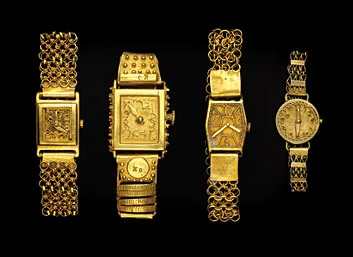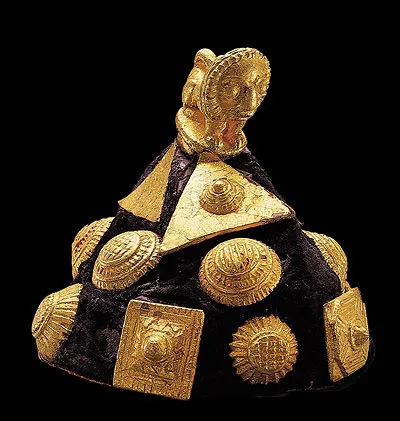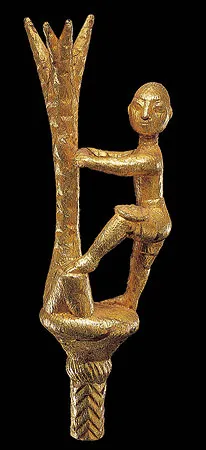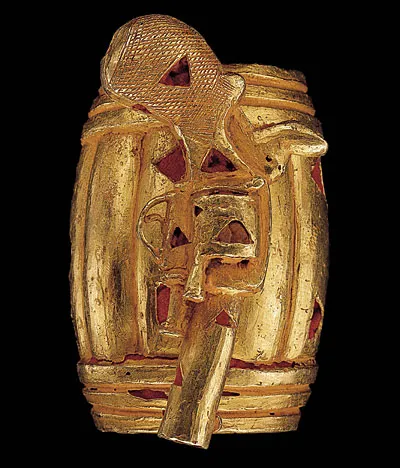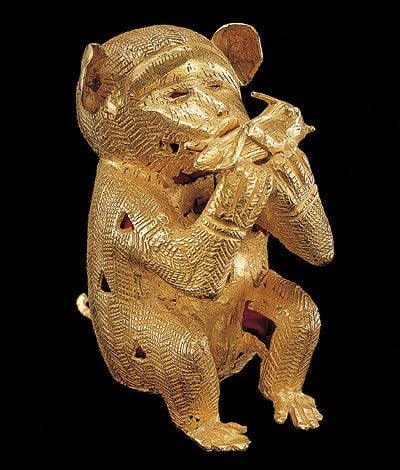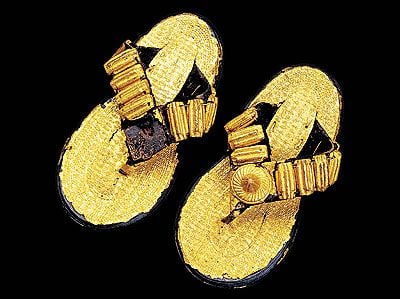West African Gold: Out of the Ordinary
The inventive goldwork and royal regalia of Ghana’s Akan people on display in a new exhibition are drawn, strikingly, from daily life
Thomas Bowdich, a British envoy, was one of the first Europeans to venture into the interior of Africa’s fabled Gold Coast. Entering the town of Kumasi, in what is now Ghana, in 1817, Bowdich was stunned to behold a local chieftain encrusted in glittering gold jewelry. “One wrist is so heavily laden with gold,” he wrote, “that it is supported on the head of a small boy.”
If your idea of chunky jewelry is pinkie rings or old-school gold chains, then a close look at the kind of gold finery that astonished Mr. Bowdich will redefine your notion of serious bling. Now on display at the Museum of Fine Arts, Boston through March 26, 2006, "West African Gold: Akan Regalia from the Glassell Collection" presents 130 cast, embossed or gold-leafed adornments—some old, some new—along with samples of a second coveted genre of Ghanaian art, hand-woven kente cloth. The Akan gold in the exhibition is drawn from the collection of the Museum of Fine Arts, Houston, where it was on view last year. The show will also travel to the Smithsonian’s National Museum of African Art in Washington, D.C. (May 17 to November 26, 2006).
"There’s a very elaborate tradition of chieftaincy or kingship in Ghana that’s still thriving," says art historian Doran H. Ross, author of the exhibition’s catalog. For centuries among the Akan peoples of southern Ghana, kings and their retinues have proclaimed their status in spirited public festivals, where they parade with dazzling gold regalia: necklaces, rings, bracelets, amulets, even gilded muskets and finials for umbrellas (used to shade parading chiefs). The display of regalia today may be as lavish as it’s ever been, says Ross, a regular at Akan festivals since 1974.
Akan processions are not sedate, single-file marches but are more like Mardi Gras in New Orleans. They are filled, in British historian Thomas McCaskie’s words, with “dense masses of people, intense noise—drumming, firing, cheering, singing, yelling, crying, debating—and a seemingly chaotic, highly fragmented, and relentlessly sustained assault on all the human senses.” A major event can draw thousands of people to a sit-down affair, or durbar, in a 40,000-seat sports stadium.
Gold has long been at the heart of Akan culture. The Ghanaian interior is rich in its deposits, and goldworking was already a well-honed art when Portuguese traders first anchored off Ghana’s rocky coast in the late 1400s. The Gold Coast, as it became known, was soon a center of the worldwide trade in gold, drawing fleets of European merchant ships laden with cargoes of cloth, metalware, firearms and liquor. The Portuguese, Danish, Dutch and English in turn erected coastal fortifications to safeguard their trading interests. (By the 18th century, thick-walled chambers in these forts were housing an even more lucrative export: chained captives awaiting shipment to the Americas.) Around 1700, the Akan’s most populous ethnic group, the Asante, proclaimed their own “Kingdom of Gold” in the interior. In the 19th century, the Asante fought several wars against England, which finally claimed the Gold Coast as a crown possession in 1901.
In today’s Ghana—independent since 1957—the Akan peoples comprise some 125 traditional states, or chiefdoms, which endure as vestiges of the country’s precolonial culture. Although these states exist outside Ghana’s formal governing framework, their leaders wield a great degree of local authority. Over the centuries, the most elaborate goldwork has been commissioned by these ruling elites and brandished at the installation of new chiefs. (Rulers are normally appointed, most often by a queen mother, with the approval of the elders of the community.)
Historically, these treasures have been central to a community’s identity. In 1869, a chiefdom mourned the loss of both warriors and regalia in a skirmish with a rival state. With the regalia’s recovery the next day, however, the chiefdom celebrated the battle as a victory.
A chief today may wear a crownlike gold-trimmed headpiece, but his most regal adornment is his golden footwear. “Sandals among the Akan serve the same role as crowns among European royalty,” says Ross. “It’s not uncommon to go to a major Akan festival and see six or seven sandal-bearers toward the front of the procession, each carrying a pair of the chief’s sandals.” According to two German missionaries held captive by the Akan in the early 1870s, the purchase of a worn-out pair of royal sandals without the king’s permission ended with the miscreant’s beheading.
The Akan’s inventive goldwork can convey boasts, insults, jokes and especially proverbs. A parading chief who raises one hand and languidly turns his wrist to call attention to an enormous gold ring in the form of a fish may be reminding his audience of the Akan proverb: “A fish out of water dies; a king without followers ceases to exist.” The finial atop an ornate wooden staff created around 1940 by the celebrated Ghanaian woodcarver Osei Bonsu depicts a man holding an egg (p. 4) and evokes the proverb: “To be ruler is like holding an egg in the hand; if it is pressed too hard it breaks; but if not held tightly enough it may slip and smash on the ground.” Both proverbs testify to the limits of chiefly power.
Indeed, an Akan chief’s golden paraphernalia, most of it between 8 and 12 carats, is usually seen as the property of the traditional state. (During wars, the gold would sometimes be melted down to raise funds.) A ruler who drapes himself and his entourage in gold jewelry for all to see demonstrates that the communal treasure is intact. “In fact, a new chief is often expected to add items of regalia to the treasury,” says Ross.
This demand for new pieces is one reason Akan goldsmithing has always had an innovative flair. Cannons and powder kegs became popular motifs following the Europeans’ arrival. With European influence growing in the late 19th century, the lion—uncommon in Ghana—became popular in Akan art. (It was not, however, an African lion, but a stylized, Rule-Britannia sort of beast.) “The Dutch, the Danish and the British all had lions on their royal arms and on their ships,” says Ross. By the turn of the century, Akan finery also included meticulous copies in gold of extravagant Victorian brooches and necklaces. Today, chiefs and other dignitaries often sport gold bracelets intricately fashioned to look like high-end wristwatches.
The more than 900 objects at the Houston Museum were acquired over the years by oil-and-gas entrepreneur Alfred C. Glassell, who donated the collection in 2001. “A community will sell off some of its regalia thuat is old or damaged and will make new pieces,” says Houston curator Frances Marzio, who organized the current exhibition. “There’s no stigma attached to doing that, because most of these are not sacred objects.”
Though they remain locally influential, Akan chiefs these days have more social prestige than real political power. “The chiefs I know are bankers and lawyers with college degrees, and their English is excellent,” says Ross. And if a chief wearing a gold facsimile wristwatch wants to know the time, he’ll likely glance at a conventional watch on the opposite wrist.
